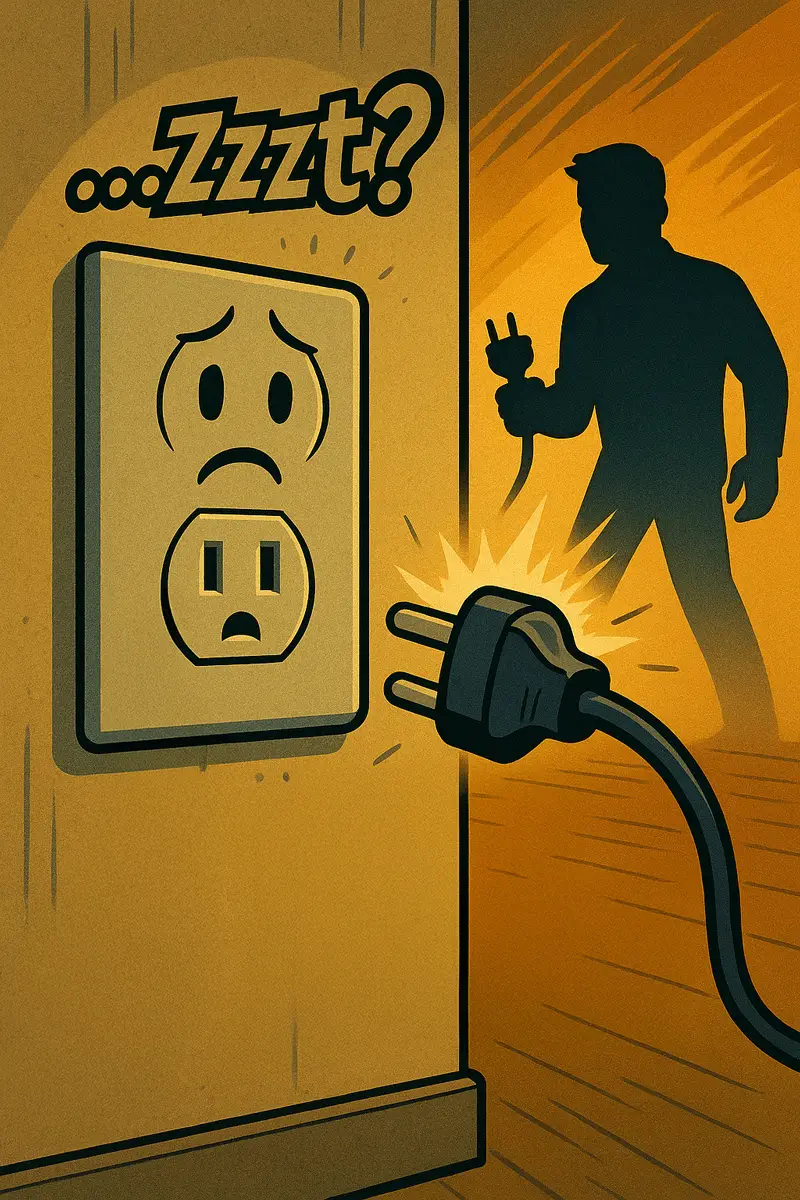
A dead outlet is an electrical outlet (the socket on the wall) that is not providing power at all. You plug in your phone charger, lamp, or toaster, and nothing happens – no juice. Symptoms are straightforward: devices won’t turn on, and other outlets or lights on the same circuit might still work fine, making it clear that one outlet is kaput. Sometimes one half of a duplex outlet works (the top plug, say) while the bottom doesn’t, which is another hint of an outlet-specific issue.
The Dead Outlet is a familiar foe in many homes. Why? First off, GFCI outlets (the ones with reset buttons often found in kitchens, bathrooms, garages, etc.) can cause other outlets in the same circuit to go dead if the GFCI trips. So you might think an outlet is dead, not realizing a GFCI in the basement popped due to moisture. Older homes around DC often have quirky wiring layouts – one outlet in the living room might be protected by a GFCI in a far-off bathroom. Additionally, older wiring and outlets can simply wear out. The metal contacts inside an outlet can loosen over decades of use (especially if folks yank cords out by the wire). In some lovely older row homes, we’ve seen outlets that were backstab-wired (a common quick wiring method) work loose over time, resulting in intermittent power or none at all. Lastly, outlet circuits controlled by wall switches (common in bedrooms for lamp circuits) can confuse homeowners – if the switch is off, the outlet feels “dead” when it’s actually just turned off. All these factors mean that dead outlets are a frequent call we get in the DMV area – from new condos to 50-year-old ramblers.
A dead outlet in itself isn’t usually an immediate danger – there’s no power, after all. The real concern is what caused the outlet to stop working. It could be a tripped GFCI, which implies there was a ground fault (possibly water got where it shouldn’t, or a device shorted) – that scenario in itself is a safety mechanism doing its job. But if a GFCI isn’t involved, a dead outlet might indicate a loose connection or burnt-out wiring at that outlet. When wires come loose from an outlet’s terminals or internal parts crack, they can arc or spark before failing completely. Those arcs produce heat. If you’ve ever seen an outlet with scorch marks or smelled burned plastic around it, that’s a sign it failed in a dangerous way. Even without obvious burning, a failed outlet might have damaged wiring insulation behind it. Additionally, a dead outlet could mean part of the circuit is compromised – potentially affecting downstream outlets in a daisy-chain. So while the outlet not working is an inconvenience, the hidden electrical fault that caused it needs prompt attention to prevent potential fire or shock hazards.
You can do a couple of simple checks before calling the pros: if it’s a GFCI outlet or there’s one on the same circuit, try hitting the “Reset” button. Also, identify if a wall switch controls that outlet and make sure it’s on (a very common oops!). If after these steps the outlet is still dead, or especially if you notice any burn marks or it made a popping sound before dying, call a licensed electrician. Here’s why: fixing a dead outlet often isn’t as simple as swapping the receptacle – you need to verify the wiring is intact and that there’s not a bigger issue on the circuit. An electrician will use a tester to see if power is reaching the outlet. If not, they’ll trace the circuit to find where the break or loose connection is. In many cases, we find another outlet or junction upstream that has a loose wire, cutting power further down – a tricky find without experience. If the outlet itself failed (we’ve seen old, cracked outlets that just give up), the electrician will safely replace it with a new, code-compliant receptacle. They’ll also check if your home’s outlets are properly grounded; in older houses, sometimes an outlet “dies” after a DIYer tried to upgrade a two-prong to a three-prong without proper grounding – and it never was wired right to begin with. The peace of mind of having a pro ensure the circuit is safe and sound is well worth it. And of course, once fixed, that outlet will be back to work powering your coffee maker and phone chargers, making life a bit more convenient again.
A non-working outlet might seem like a small annoyance – until your fridge or Wi-Fi is plugged into it! Rather than running extension cords as a band-aid, let Dr. Electric sleuth out the source of the outage. Often the fix is quicker (and cheaper) than you’d expect. It’s a bit like performing CPR on your electrical system – we jump-start that dead outlet and ensure the whole circuit is healthy, so your home stays safe and fully energized.
Dr. Electric offers a range of services to enhance safety, reliability, and performance. Get in touch or check out our List of Common Electrical Requests.
You can also text our support team at 833-337-3532 or email: info@drelectric.com